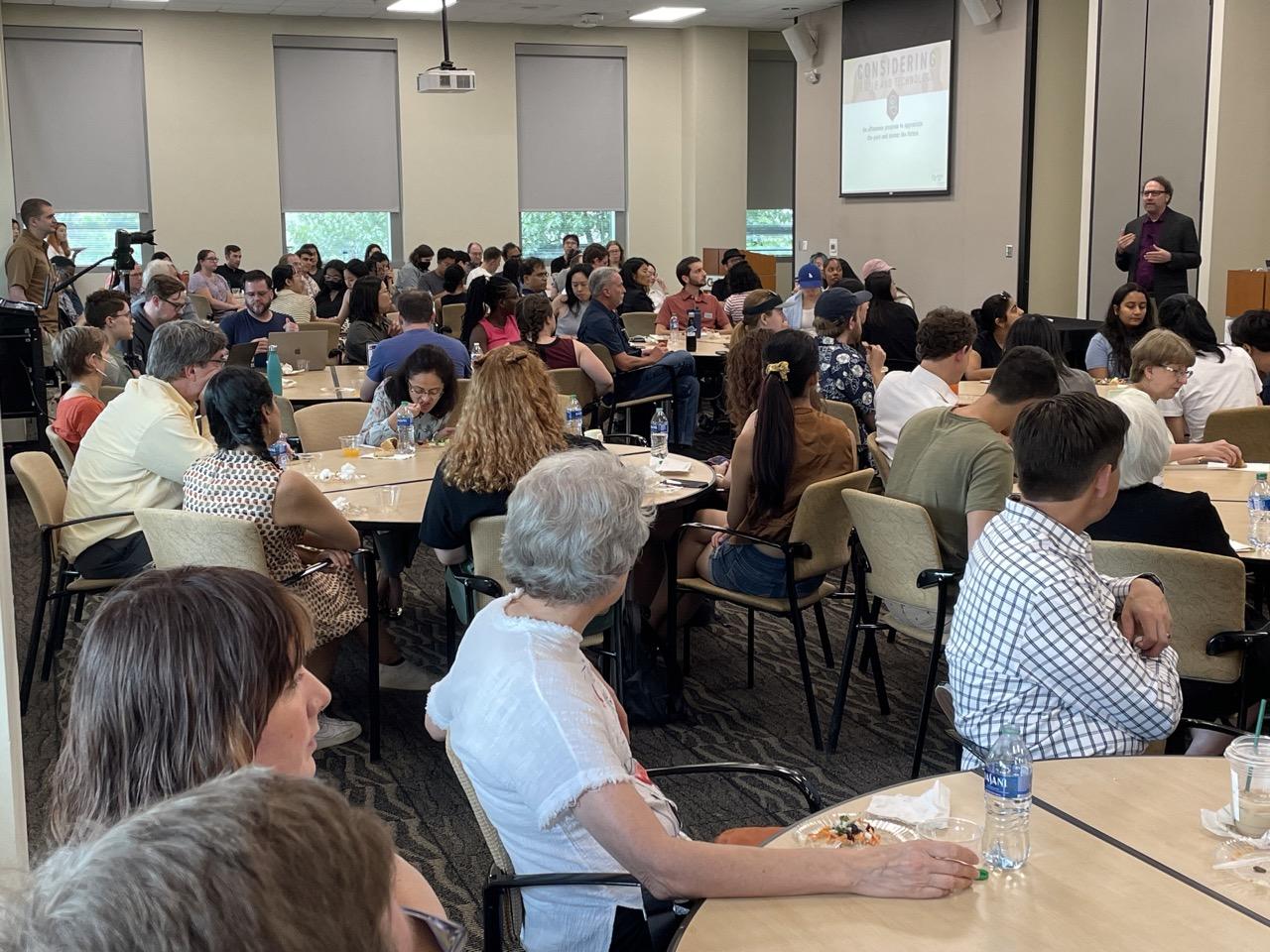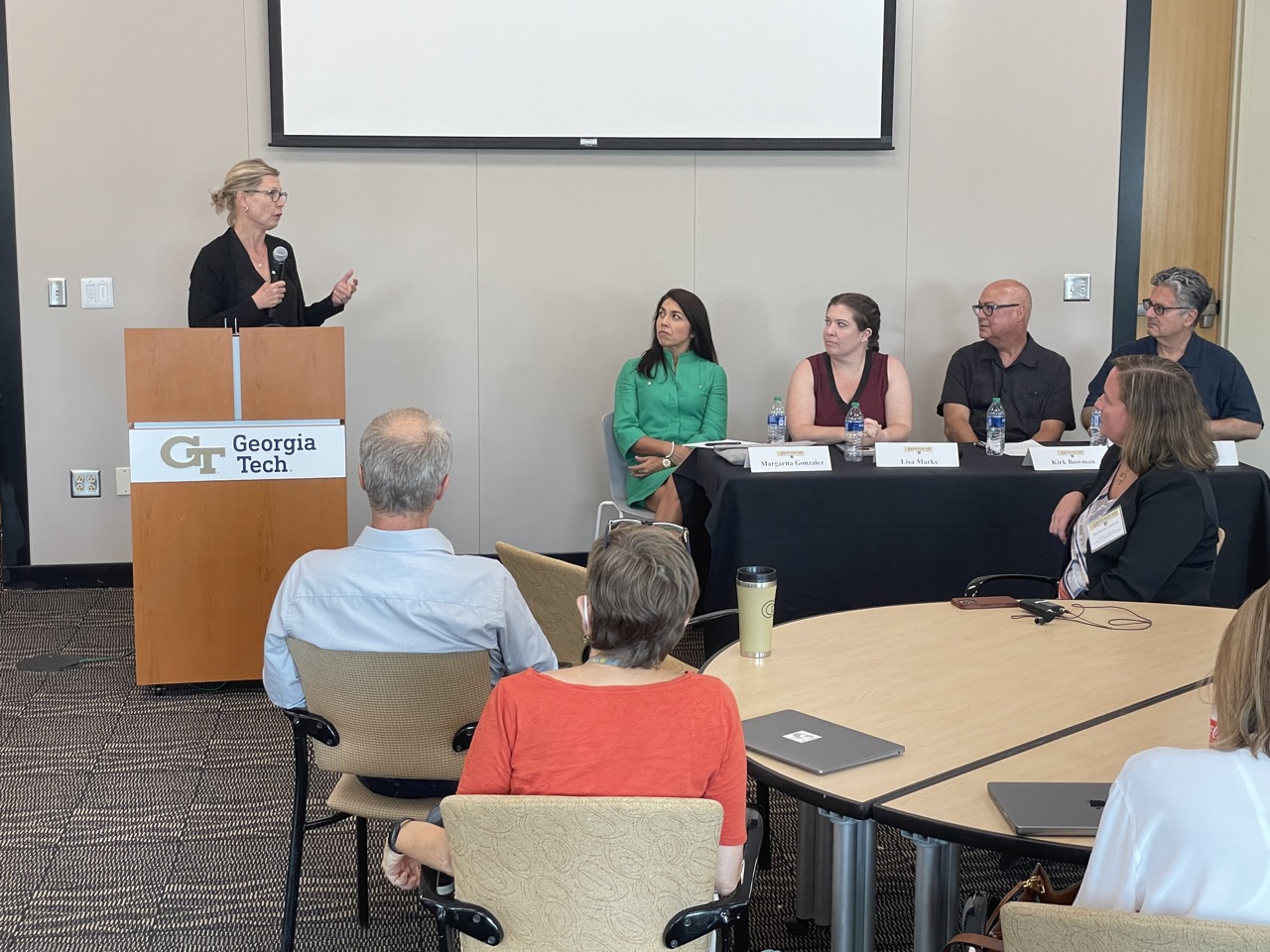Event Announcement: Considering People and Technology
Sep 24, 2023 —

Michael Best
Event Overview
On Aug. 24, the Institute for People and Technology (IPaT) sponsored its first fall program aptly named Considering People and Technology. This large IPaT community event focused on people and technology, past and present, and kicked off with a GVU Brown Bag lecture presented by IPaT's new executive director, Michael Best. His talk was titled, “Considering IPaT: Celebrating the Past and Inventing the Future.”
After the lecture, IPaT offered a tour of its labs, a panel discussion featuring distinguished members of the Georgia Tech community in a continuing discussion about people and technology, and ended with a high-spirited reception for guests and speakers. More than 115 people across Georgia Tech, Emory, and other organizations attended Best’s talk delivered to this standing-room-only crowd in the first-floor ballroom in the Technology Square Research Building. This was followed by another large crowd that attended the panel discussion held later in the afternoon.
The panel discussion, focused on the future of people and technology, was moderated by Maribeth Gandy Coleman, director of research for IPaT and a Regents’ Researcher. She is a computer scientist focused on developing novel and scientifically validated systems at the “human technology frontier” designed for purposes such as training, rehabilitation, and cognitive therapy.
Eight distinguished Georgia Tech faculty members across academic disciplines participated in the discussion:
- Gen. Philip Breedlove, former NATO Supreme Allied Commander Europe and distinguished professor in the Sam Nunn School of International Affairs, Ivan Allen College of Liberal Arts.
- Margarita Gonzalez, principal researcher and senior technologist for digital innovation at the Georgia Tech Research Institute in the Information and Communications Lab.
- Tansu Celikel, chair of the School of Psychology, College of Sciences.
- Matthew Gombolay, assistant professor in the School of Interactive Computing, College of Computing.
- Lisa Marks, assistant professor in the School of Industrial Design, College of Design.
- Sabir Khan, associate professor and director of the Architecture International Education Program in the School of Architecture, College of Design.
- Kirk Bowman, Regents' Entrepreneur and John R. Wilcox Term Professor of Global Development and Identity in the Sam Nunn School of International Affairs, Ivan Allen College of Liberal Arts.
- Ruthie Yow, service learning and partnerships specialist, Serve-Learn-Sustain.
Julia Kubanek, Georgia Tech’s vice president for Interdisciplinary Research, delivered closing remarks for the event.
Considering IPaT: Celebrating the Past and Inventing the Future
“This is a really exciting time to be part of the IPaT family. What IPaT is doing in my estimation cannot be underestimated in terms of the intellectual promise and real-world impact,” said Best. “In addition to IPaT moving to a brand-new space on campus, we’ve also merged with the GVU Center, which has combined two intellectual and research powerhouses along with extraordinary communities where useful synergies and economies of scale will let us build not 1+1=2, but 1+1=20.”
Best, who just started his first year as IPaT’s executive director, is looking for ways to build on IPaT’s strengths to make sure that Georgia Tech’s interdisciplinary community is thinking about the people and technology nexus so that it’s meaningful, creative, and fun when conducting research in partnership with IPaT.
“There is nothing out there, whether it's climate change or political upheaval, that do not have a profound people and technology interface,” said Best. “If you care about global challenges and responding to them, IPaT is the place to be. This is where it's happening.”
Best went on to connect his global perspective to responses to any global challenge. “I'm a professor in the Sam Nun School of International Affairs, I’ve worked with the United Nations, and all of my research work prior to the pandemic occurred outside of the U.S. I'm going to bring my global and international perspective to what I do as the executive director of IPaT. I think that there's an enormous amount of opportunity for building global engagements, especially if we’re focusing on global challenges.”
IPaT is one of 10 Georgia Tech interdisciplinary research institutes (IRI). The goal of these IRIs is to bring together researchers from different disciplines to address topics of strategic importance to Georgia Tech.
IPaT activities encompass industry and community partnership programs, industry engagement projects, and providing research infrastructure and laboratories. It also provides thought leadership, performs outreach and communication to the general public about research, provides research seed and engagement grants, and organizes symposiums and speaker events. This is in addition to the research engineers and scientists who also provide software design and development support.
Panelists Share Thoughts on the Future of People and Technology
Maribeth Gandy Coleman, director of research for IPaT, encouraged each panelist to share challenges or opportunities in the future related to people and technology. Here are some of the thoughts they shared:
- Gen. Philip Breedlove recalled major advances in cockpit fighter technology ranging from better aircraft handling, new laser range targeting, and the arrival of night vision inside pilot helmets. He envisions artificial intelligence (AI) assisting fifth-generation aircraft fighter pilots by processing data from a myriad of sensors, synthesizing the data to the most important things, and displaying this information in a way that is immediately usable and visible to the pilot to fulfill the need for different types of missions. He also stated that sixth-generation fighter planes are probably being designed with new pilot-plane advancements further incorporating AI.
- Margarita Gonzalez commented that although AI advances seem to be accelerating, AI cannot imitate human empathy, emotional understanding, human imagination, human intuition, and our human capacity to self-reflect. She acknowledged Peter-Paul Berbeek’s work on technology mediation theory, and more broadly the morality of technology. She remarked, “One of the greatest challenges that we face is to holistically understand the implications of our technology-mediated existence.” According to Gonzalez, “The future opportunity in the people and technology space is to update or upgrade our normative framework, the set of ethical principles and values that guide our behavior, and creative technology integration through our lives.”
- Tansu Celikel said, “we’re entering a new era where AI will be integrated into everything and it’s time to start thinking about human AI core evolution.” He was referring to the cognitive evolutionary pressure for humans to be able to keep up with the additional AI intelligence that is emerging alongside human intelligence. He remarked that new cognition for humans and human-made devices will give rise to new technologies that will then become part of society and we’ll need to be co-evolving with these advancements as a community.
- Matthew Gombolay previously worked with the U.S. Navy to help improve ship defenses with decision support tools to help a naval tactical action officer decide what weapons and countermeasure defenses to deploy, along with when, where, and how, among a set of distributed ships to defend themselves against a raid of enemy anti-ship missiles. He stated, “There is actually no middle ground where a machine and the human are collaborating and communicating to decide what are my possible lifesaving options?” He stressed that cultural factors, team factors, and profession-related factors influence decision-making in different settings. “I think that we need to invest a lot in defining cultural-specific components for AI, and then enabling end users to actually be able to communicate with these systems and decide what is the most efficacious course of action and collaborate on making that happen.”
- Lisa Marks commented that the best invention humans have created was string. And the invention of string led to spindles and whorls, which became the basis for gears and pulleys, in combination with the invention of the loom, which became a basis for computation and computers. “When I started working at Georgia Tech, I did not expect that my research in lace was going to go to outer space and the depths of the ocean,” said Marks. She said that AI will be helping to create new, complex structures, such as coral building objects, or other objects with specific properties to help solve more of tomorrow’s problems such as the loss of coral or the collection of space debris.
- According to Sabir Khan, “History is full of examples where technology was partly responsible for the destruction of people, cultures, and society.” He said AI will be part of the future in warfare. He also said that we’ll need to be more mindful of the intersection of society and technology as advancements are achieved.
- Kirk Bowman emphasized that new technologies can empower one group over another and more inequality can result, such as the invention of barbed wire to separate or corral people. He also noted that new technology can help bridge inequality such as the use of Velcro, instead of pins, by female football players to help keep their head scarves attached to enable them to play in a world championship. He stressed that one of the opportunities that we have is think more deeply about whether local communities need a new technology or need, perhaps, a lower technology solution.
- Ruthie Yow said, “In our group, we imagine that communities are not people in places with problems, but rather they are people in places with gifts and strengths.” She utilizes asset-based community development, which is about the identification of assets, the connection of assets, and the mobilization of assets in a local community. She recalled a project requiring seniors to interact with an app to help save home energy, but the problem was seniors couldn’t use the app. The solution was to pair young people in the community with seniors to help them use the app. This intergenerational collaboration delivered many benefits to both the seniors and the teens and made a positive impact in the community. She sees future technology opportunities as a way to mobilize gifts and to draw together the strengths of communities.
Julia Kubanek closed the event by saying, “Our goal [at Georgia Tech] is to be able to open our minds, use the imagination that technology does not bring us, immerse ourselves in an environment that's new to us, like the new communities that Ruthie deals with, and teach our students and ourselves how to think more critically to solve problems and make new discoveries.”

Julia Kubanek talking to some of the panelists




